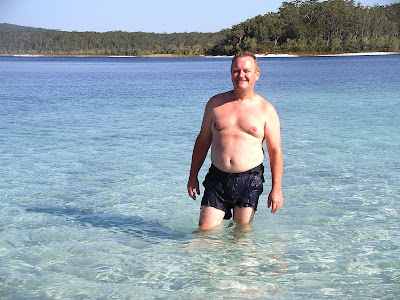The next day we continue on a scenic route along the Tweed Valley and end up in Grafton where we find a Big4 holiday park to stop in. These are a chain of camping and motorhome sites that are very big in Australia. You can’t fault them – they are clean and tidy, well run and efficient – and terribly boring. Why anyone would want such a suburban utopia when they are on holiday I can barely imagine.
Sue has bought Macadamia nuts at the side of the road – a kilo of them for $3. Unfortunately these have shells on and are proving very difficult to crack. We resort to driving over them with the van. Although this can be said to work it does tend to mash shell and nut together and leave pieces of road grit and tar embedded in them. As this is less than ideal I buy a special macadamia nut cracker in Grafton. This costs $13, but it keeps Sue occupied for days and the nuts are very good.
We take a scenic route to Coffs Harbour and have an excellent lunch at the fisherman’s co-op by the harbour. We find camping outside the town and I go for a walk to Muttonbird Island.


The next day we decide to take a scenic drive inland. We follow the Waterfalls Way toward Dorigo. It is another winding road that climbs through forested valleys. When we reach more open farmland we stop, intending to have lunch, but as soon as we opened the door – flies. On several occasions we try but each time the flies drive us on. The countryside looks pleasant and well ordered agricultural land but the flies don’t go away. They try to get up your nose and in your eyes and ears and mouth. Giving up, we head back to the coast again through endless miles of twisting and turning forest road. Eventually we find a truck-stop at the side of the road in Wauchope where we camp for the night.
Sue spends much of the night scratching herself. The sand flies seem really to have caught both of us since Coffs Harbour and we are covered in bites. In the morning we continue on to Port Macquarie where we park by a beach for Sue to swim – actually it is too rough, she just jumps around in the surf.
We drive on down the Pacific Highway and the Great Lakes Way and eventually find ourselves at Beuladelah where we turn off to Myall Shores and camp at the edge of a lake at an “Eco resort” (costs the same as a Big4 but scruffy like a cheap site).
In the morning we take a ferry across to the south side of the lake and find our way back to the Pacific Highway. We realise after visiting an Information Centre that we are near the Hunter Valley wine region so take the road for Cessnock and do a tour at Tyrrells. We get to do tastings both before and after the tour and they seem quite generous so I have to hold myself back as there is more driving to do. We carry on to cross Wiseman’s Ferry and stop at a site by the Hawkesbury river for the night. Sydney tomorrow.



























